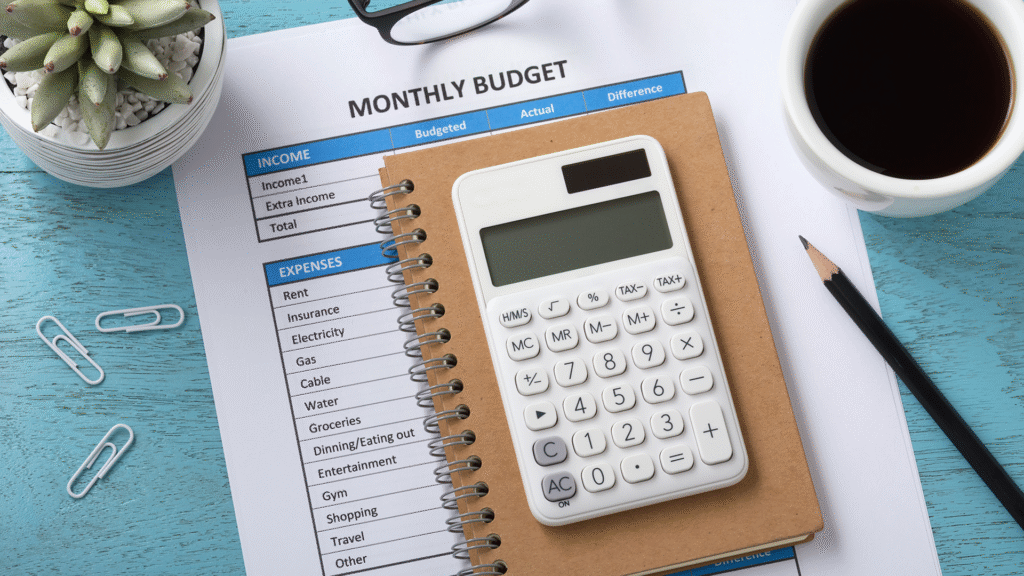Budgeting is the backbone of financial success. It’s not just about tracking where your money goes; it’s about actively deciding how to allocate your income to meet your needs, wants, and goals. Whether you’re trying to save for a major purchase, pay off debt, or simply gain control over your finances, budgeting is the tool that can help you achieve it. This guide will break down the essentials of budgeting into actionable steps, so you can start managing your income and expenses effectively.
Key Takeaways
- Always budget based on your net (take-home) income to ensure realistic and sustainable spending.
- Categorize expenses into fixed, variable, and discretionary to easily identify areas for adjustment.
- Set clear financial goals and regularly track your progress using tools or apps that suit your style.
- Automate savings and review your budget periodically to adapt to income changes and unexpected expenses.
What is Budgeting and Why Does It Matter?
Budgeting is a financial plan that helps you allocate your income toward expenses, savings, and investments. It provides clarity on spending habits, prevents overspending, encourages saving, and helps achieve financial goals-both short-term and long-term. By creating a budget, you gain control over your money instead of letting it control you. This ensures that every dollar has a purpose, whether it’s paying bills, saving for the future, or enjoying life’s luxuries responsibly.
Understanding Your Income
To create a budget, you must first know how much money you have coming in. Focus on your net income-the amount you take home after taxes and deductions. This includes your salary or wages, freelance earnings, rental income, and any other sources of income. Knowing your net income ensures realistic budgeting and helps you set achievable spending limits.
Gather documentation such as pay stubs or bank statements to calculate your monthly net income accurately. If you have irregular income (e.g., freelancing), consider using an average of earnings over several months to create a baseline.
Example:
- If your gross monthly salary is $5,000 but after taxes and deductions (health insurance premiums or retirement contributions), your net income is $4,200-this is the amount you should base your budget on.
If you have irregular income (e.g., freelancing), consider using an average of earnings over several months to create a baseline. For instance:
- If one month you earned $6,000 and another month $3,000, calculate an average income of $4,500 to build a realistic budget.
Categorizing Your Expenses
Categorizing expenses allows you to understand where your money goes and identify areas for improvement.
- Fixed Expenses: These are non-negotiable costs that remain constant each month. Examples include:
- Rent: $1,200/month.
- Car loan payment: $300/month.
- Insurance premiums: $150/month.
- Variable Expenses: These fluctuate from month to month based on usage or lifestyle choices. Examples include:
- Groceries: $400 one month and $350 the next.
- Entertainment: $100 for concert tickets one month but only $50 for streaming subscriptions the next.
- Discretionary Spending: Non-essential expenses that can be adjusted or eliminated if needed:
- Shopping: Buying new clothes ($200/month).
- Travel: Weekend getaway ($500).
By categorizing these expenses into fixed, variable, and discretionary categories, you can identify areas where adjustments can be made-for instance, reducing dining out expenses from $300/month to $150/month.
Setting Financial Goals
Setting clear financial goals gives purpose to your budget. Begin by identifying both short-term and long-term goals.
Example of Short-Term Goal:
- Build an emergency fund worth three months of living expenses (e.g., $9,000 if monthly expenses are $3,000). Start by saving $750 per month for 12 months.
Example of Long-Term Goal:
- Save for a down payment on a house worth $40,000 in five years. Allocate $670 per month toward this goal.
Using SMART criteria ensures these goals are actionable:
- Specific: Save $40,000 for a house.
- Measurable: Track progress monthly ($670/month).
- Achievable: Based on current income and expenses.
- Relevant: Aligns with personal priorities (homeownership).
- Time-bound: Achieve within five years.
Choosing a Budgeting Method
There are several budgeting methods available; choose one that suits your lifestyle:
- 50/30/20 Rule: Allocate 50% of your income to needs (essential expenses), 30% to wants (discretionary spending), and 20% to savings and debt repayment.
- Zero-Based Budgeting: Assign every dollar of income a specific purpose until no money is left unallocated at the end of the month.
- Envelope System: Use cash envelopes for different spending categories to limit overspending.
Experiment with different approaches to find what works best for your financial situation and personality.
Tools and Techniques for Tracking Your Budget
Tracking ensures that you stay on course with your budget plan. You can choose between manual tracking methods or digital tools based on what works best for you.
Example – Manual Tracking:
Use an Excel spreadsheet to list all income sources and expenses each month. For instance:
- Income: Net salary = $4,200.
- Expenses: Rent = $1,200; Groceries = $400; Utilities = $150; Savings = $500; Discretionary spending = $600.
At the end of the month, compare actual spending with planned amounts to identify areas needing adjustments.
Example – Digital Tools:
Apps like Mint automatically categorize transactions from linked bank accounts. If you spend $100 at a grocery store or pay a utility bill online for $150, Mint tracks these transactions in real-time under their respective categories.
Adjusting Your Budget Over Time
A budget isn’t static; it evolves as your financial situation changes. For example:
- If you receive a raise increasing your net monthly income from $4,200 to $5,000-allocate the extra funds toward savings (e.g., increase emergency fund contributions from $500/month to $700/month).
Similarly, life events like marriage or having children may require adjustments:
- Add new categories such as childcare costs or increased health insurance premiums.
Regularly reviewing your budget ensures it remains relevant and effective in helping you achieve financial goals despite changes in circumstances.
Overcoming Common Budgeting Challenges
Many individuals face challenges like irregular incomes or impulse spending habits when budgeting.
Example – Irregular Income:
If you’re a freelancer earning between $3,000–$6,000 monthly:
- Use an average income of $4,500 as a baseline for budgeting.
- During high-income months ($6,000), allocate extra funds toward savings to cover low-income months ($3,000).
Example – Impulse Spending:
If you tend to overspend on shopping (e.g., buying unnecessary gadgets worth hundreds of dollars):
- Set limits on discretionary spending categories (e.g., cap shopping at $150/month).
- Implement “cool-off periods” where purchases above a certain amount require waiting 24–48 hours before committing-this reduces emotional purchases.
Benefits of Automating Savings
Automation simplifies financial management while encouraging consistent saving habits.
- Set up automatic transfers from checking accounts into savings accounts on payday (“pay yourself first”).
- Automate bill payments to avoid late fees and improve credit scores.
- Use recurring investments in retirement accounts or mutual funds to build wealth passively over time.
Automation reduces manual effort while ensuring that saving becomes a priority rather than an afterthought.
Planning for Unexpected Expenses
No matter how well-planned a budget is, unexpected expenses will arise-be prepared by building an emergency fund.
- Aim for three to six months’ worth of living expenses in an easily accessible account.
- Include insurance premiums in your budget as protection against significant unforeseen costs like medical emergencies or accidents.
An emergency fund acts as a financial safety net during difficult times, preventing reliance on credit cards or loans when unexpected costs occur.
Conclusion
Budgeting is more than just balancing numbers; it’s about taking charge of your financial destiny through informed decision-making and proactive planning. By understanding income sources, categorizing expenses accurately, setting clear goals, selecting appropriate budgeting methods, utilizing tracking tools effectively, adjusting budgets flexibly over time-all contribute toward building a solid foundation for financial health.
Ultimately, mastering budgeting empowers individuals not only to manage their current finances but also lays the groundwork for future wealth-building endeavors-leading toward greater security and peace of mind in one’s financial journey.


